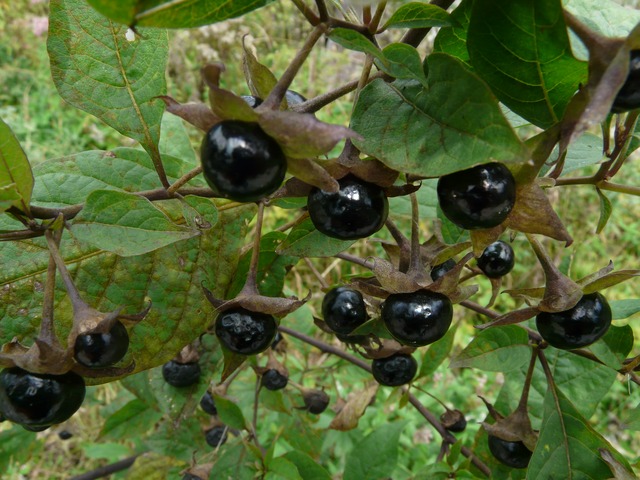 |  |  |   |  |
  |  |
Deadly Nightshade
is a perennial plant that can grow to an average height of 50-200 cm, covered with dark green leaves. At the top of the stem, it divides into three branches, which then also divide, forming a forked structure of the plant. Leaves entire, on stems, glabrous, lower arranged alternately, upper nearly opposite. The lower leaves of the plant are large, up to 22 cm long and 11 cm wide, the smallest 7.5 cm long and 3.5 cm wide. Oppositely arranged leaves have one characteristic, one leaf is always larger than the other, the largest is elliptic and pointed, the smallest is ovate.
Flowers are formed in leaf axils, solitary, relatively large, brown-violet in color, 20-30mm long, 14-20mm in diameter.
The fruit of the
deadly Nightshade
is a black, shiny, juicy, multi-seeded berry, the size of which is like a cherry. It has a sweet taste and is poisonous, like all parts of the plant. The
deadly Nightshade
blooms in June-August, the fruits begin to appear from July.
In medicine, the leaves, stems and roots of the
deadly Nightshade
are used for medicinal purposes. In warm climates and if properly cared for, the
deadly Nightshade
lives an average of 5 years. During one summer, leaves are collected from the plant 2 to 5 times and then they are dried in forced dryers. Collect the leaves by hand. When the plant begins to bloom, collect the lower leaves - up to the point where the stem branches. At the end of flowering, collect the leaves from the new shoots. When the plant begins to produce berries, it is cut, leaving a 10 cm long stem above the ground. The cut plant is divided into 4 cm pieces and dried. Roots are dug in autumn, washed, divided into pieces of 10-20 cm, if necessary, cut lengthwise and dried.
As a result, three types of drugs are obtained: leaves, stems and roots. The leaves and stems are dried quickly, not exceeding 40C in the dryers. The roots are dried, spread out on sieves in a shaded, well-ventilated place. This plant is grown in one place for 5-6 years and then the place of plantation is changed. Leaves and stems are stored for 2 years, rhizomes for 3 years.
The collected parts of the plant must be dried as soon as possible!
The plant contains the following alkaloids: hyoscyamine, atropine - on average 4% in roots, 0.14-1.2% in leaves, 0.2-0.65 in stems, 0.24-0.6% in flowers, 0.7% in ripe fruits. Scopolamine, apoatropine, balladonine, as well as volatile substances: N-methylpyrroline, N-methylpyrrolidine, pyridine and flavonoids, oxycoumarins are also found in the leaves. The roots also contain the alkaloid kuschigrin.
Medicinal significance
The main alkaloid in the
deadly Nightshade
is atropine - it dilates the pupil of the eye. It suppresses the activity of all secretory glands in the digestive tract, suppresses the activity of sweat glands, and also relaxes the smooth muscles of the bronchi and stomach. Large doses of atropine cause excitement - both physically and psychologically - by acting on the cerebral cortex.
Folk medicine has abandoned this plant because of its strong toxicity. However, in ancient times it was used to treat ulcers and tumors, inflammation of the stomach and liver, and reduce fever. Deadly Nightshade
extracts, along with wine and juices, were used both orally and externally to relieve all types of pain.
The following may occur with systematic use of
deadly Nightshade
preparations: headache, increased nervousness, drowsiness, weakness, dizziness, ataxia, speech disorders, dry mouth, loss of taste, loss of appetite, constipation, as well as visual disturbances and increased sensitivity to light. These features should be especially taken into account when atropine-containing preparations are used for people whose work is associated with increased responsibility. When used externally, there are also side effects: increase in eye pressure, visual disturbances, paralysis of accommodation and photophobia. With an overdose of atropine, toxic manifestations may begin to appear: agitation, blackout of consciousness, convulsions and hallucinations.
All parts of the
deadly Nightshade
are highly poisonous. Eating 10-20 of its fruits can be fatal. Atropine, which is present in the
deadly Nightshade
, is not to be used in case of glaucoma, as well as during the lactation period, because it can "rip off" the milk.
